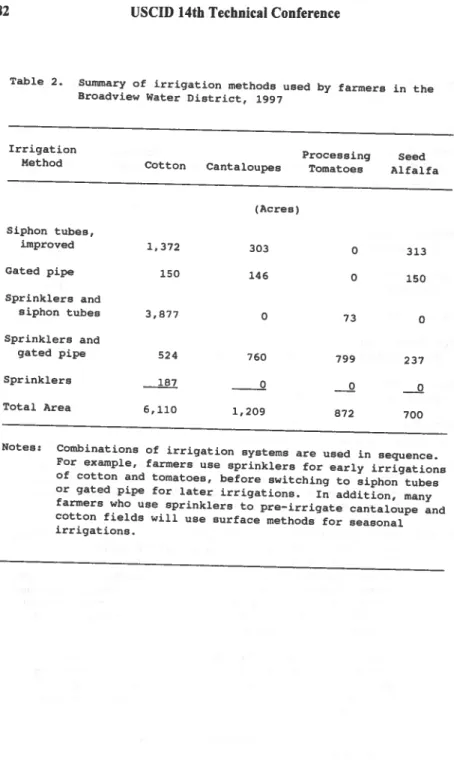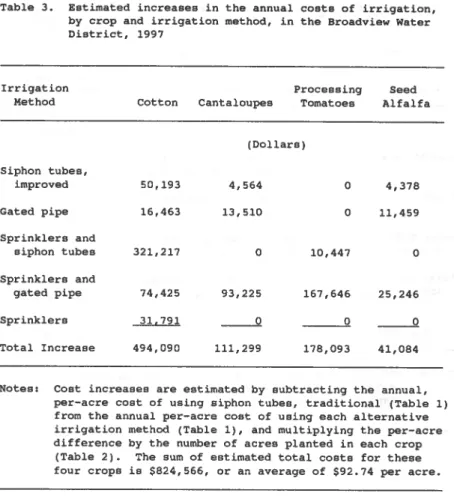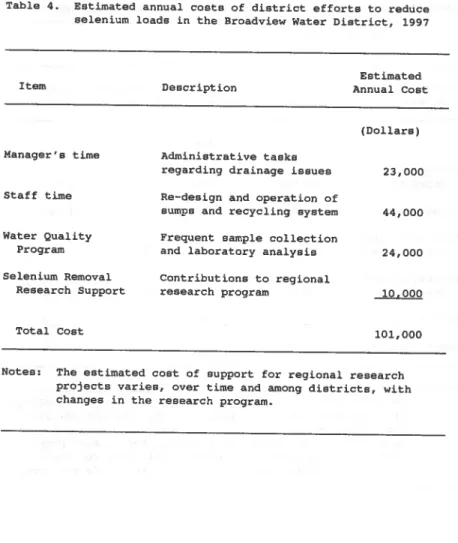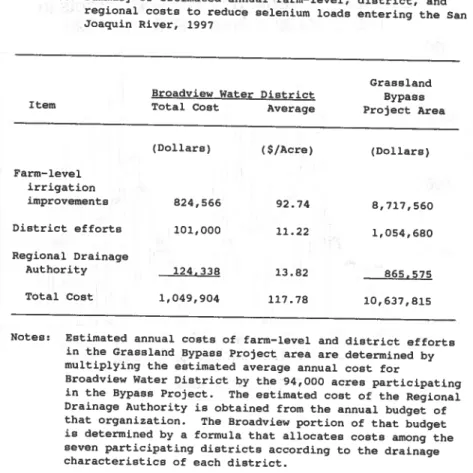ESTIMATING THE COSTS OF FARM-LEVEL AND DISTRICT EFFORTS TO ACHIEVE SELENIUM LOAD TARGETS
Dennis Wichelns l Shannon Fretwel13
ABSTRACT
David Cone2 Kristen Ward4
Seven irrigation and drainage districts in the California's San Joaquin Valley are participating in a regional program to reduce the load of selenium entering the San Joaquin River. Farmers have improved their irrigation methods to reduce surface runoff and deep percolation, district staff have improved their operations to support farm-level water management efforts, and a regional association has been formed to operate regional drainage facilities and coordinate efforts to achieve monthly and annual selenium load targets. The costs of these efforts include farm-level expenditures for new irrigation systems and for increases in irrigation labor and other water management inputs, district-level expenditures for new facilities and staff to manage water
deliveries and drainage water reduction efforts more aggressively, and the fixed and variable costs of operating and maintaining regional drainage facilities. Empirical estimates of these costs for the Broadview Water District in 1997 include $93 per acre for farm-level irrigation improvements, $11 per acre for district-level efforts, and $14 per acre for supporting regional drainage activities.
INTRODUCTION
Much of the subsurface drain water collected beneath farmland on the west side of the San Joaquin Valley contains selenium, boron, and other elements that occur naturally in local soils and are leached from the profile during irrigation and drainage activities (Leteyet al., 1986; Deverel and Gallanthine, 1988, Gilliom, 1991). The U.S. Environmental Protection Agency has established a national water quality criterion for selenium of 5 parts per billion (ppb), when measured as a S-day moving average concentration. The California Regional Water Quality Control Board for the Central Valley Region has adopted a Basin Plan Amendment designed to aChieve the national selenium concentration standard, over time.
1 Assoc. Professor, Univ. of Rhode Island, Kingston, Rhode Island 2 Manager, Broadview Water District, Firebaugh, California 3 Water Management Specialist, Broadview Water District
4 Graduate Research Assistant, Ag. Econ., Univ. of Calif., Davis
That amendment includes a set of monthly and annual selenium load targets that are expected to generate acceptable selenium
concentrations in the near term, while farm-level and regional efforts are implemented, over time, to achieve the national water quality standard.
The Regional Water Quality Control Board has also established a 2-ppb selenium water quality objective for sloughs and channels in a wetland habitat located between an agricultural production area and the San Joaquin River. As a result, it became necessary to remove agricultural drainage water from wetland waterways, as selenium concentrations in drainage water are often in the range of 20 to 100 ppb (Deverel et al., 1984; Presser and Barnes, 1985). Agricultural districts were encouraged by water quality agencies to form a regional drainage organization and to develop a program for achieving the selenium load targets and removing drainage water from the wetland waterways.
Seven irrigation and drainage districts in the region have formed the Grassland Basin Drainage Activity Agreement to construct and operate regional drainage facilities and coordinate efforts to achieve the selenium load targets. The group has constructed a new channel that carries drainage water from all seven districts around the wetland area to an existing portion of the San Luis Drain, which carries the water to a tributary of the San Joaquin River. That program, known locally as the Grassland Bypass Project, began operations in September of 1996.
The monthly and annual selenium load targets, which became effective in October of 1996, are substantially lower than estimates of selenium discharges in recent years. For example, the monthly load targets are equivalent to less than 50\ of the estimated discharges from the region during several months of the 1995 and 1996 crop years (please see the figure). The estimated annual load of selenium discharged in each of those years is almost twice the annual load target.
The monthly selenium load estimates for 1995 and 1996 reflect improvements in irrigation practices and drainage water management efforts that were implemented by farmers and districts in the early 1990s, when water supplies were reduced due to perSistent drought conditions and changes in public policies regarding the allocation of water among urban, agricultural, and environmental uses (Wichelns and Cone, 1992a; Wichelns et al., 1996a). Further reductions in selenium loads may be possible, but the incremental cost of achieving those reductions will likely be substantial, as the most affordable improvements in water management practices have already been implemented.
I
I
FARM-LEVEL COSTS
The potentially restrictive selenium load targets, described above, have caused irrigation and drainage districts to implement additional programs to motivate further improvements in farm-level irrigation practices that will reduce surface runoff and deep percolation, and to increase the blending and re-use of drainage water with fresh water supplies. Innovations in district policies have included tiered water pricing, low-interest loans for
purchasing new irrigation systems, and restrictions regarding surface runoff discharged into drainage ditches. Farmers have responded by replacing traditional surface irrigation methods with improved furrow methods, gated pipe, and sprinkler systems. They have also increased the labor and management components of irrigation activities.
The farm-level costs of using improved irrigation methods have been estimated by interviewing farmers in the 9000-acre Broadview Water District. Broadview implemented a tiered water pricing program in 1989 and has adopted additional incentive programs in recent years (Wichelns 1991; Wichelns and Cone 1992a and 1992b; Wichelns et al. 1996a). As a result, Broadview farmers have gained considerable experience in modifying irrigation methods to reduce surface runoff and deep percolation. Farmers have provided detailed estimates of the capital costs and variable costs of operating and maintaining siphon tube, gated pipe, and sprinkler systems (Wichelns et al., 1996b).
We compare the estimated annual costs of alternative irrigation methods for the four major crops grown in Broadview in Table 1. The estimated cost of using traditional siphon tube methods ranges from $148 per acre on seed alfalfa to $200 per acre on cotton, which requires more irrigations per season. Improved siphon tube methods include shorter irrigation run lengths and the use of a night irrigator to manage irrigation events carefully. The costs for gated pipe and sprinkler methods include a capital cost component and a larger labor requirement. Gated pipe must be carried into a field and removed at the end of an irrigation season, while portable sprinkler systems must be moved several times during each irrigation event. Detailed information regarding each cost component is provided in Wichelns et al. (1996b).
Prior to the 1990s, Broadview farmers used traditional siphon tube methods to irrigate most crops. They began improving irrigation methods in the early 1990s, in response to the district's tiered water pricing program and in an effort to maximize the value of surface water supplies that were limited by persistent drought conditions and by changes in public water allocation policies. Farmers have continued to use the improved methods as selenium load targets and uncertainty regarding their water supply have gained importance in recent years. It is unlikely that Broadview farmers will ever resume using traditional siphon tube methods.
We estimate the increased costs of irrigation by comparing the cost of irrigation improvements with the cost of using traditional siphon tube methods. For example, Broadview farmers irrigated 3,877 acres of cotton (63\ of the total cotton area) with a combination of sprinklers and siphon tubes in 1997, while using improved siphon tube methods on 1,372 acres (Table 2). The estimated cost of using sprinklers and siphon tubes on those 3,877 acres exceeds the estimated cost of using traditional siphon tube methods by $321,217, while the estimated cost increase for the 1,372 acres irrigated with improved Siphon tube methods is $50,193 (Table 3). The estimated increase in irrigation costs for all cotton fields is $494,090, or an average cost of $81 per acre. Similar analysis of estimated irrigation costs for cantaloupes, processing tomatoes, and seed alfalfa generates a total estimated increase in irrigation costs of $824,566 for the Broadview Water District in 1997, or an average cost of $93 per acre. This result represents the estimated increase in farm-level irrigation costs made necessary by selenium load targets and other public policies regarding agricultural water supplies. While it is not possible to determine the effects of individual policies or water quality programs on farm-level irrigation costs, this estimate provides insight regarding the magnitude of cost increases that have occurred on farms on the west side of the San Joaquin Valley in recent years.
DISTRICT-LEVEL AND REGIONAL COSTS
Irrigation and drainage districts have implemented several programs to support farm-level irrigation improvement efforts. These programs raise the annual cost of district operations, reSUlting in higher farm-level assessments, service fees, or water prices. For example, several districts have implemented tiered water pricing programs that require more accurate measurement of water deliveries to farm turnouts than were necessary when all water was sold at the same price per unit. Districts have also increased the flexibility with which farmers may begin or terminate water deliveries, to accommodate sprinkler systems and shorter duration irrigation sets. The quality of water deliveries has also been improved to minimize potential problems with clogged sprinkler nozzles.
Most districts in the region have begun or expanded a recycling program to blend commingled drainage water with fresh water supplies, to reduce the volume of drainage water discharged into the regional drainage system. These programs require careful monitoring of delivered water salinity to ensure that crops are not damaged, particularly when farmers are using sprinklers during early-season irrigations. Several districts have modified their water delivery and drainage systems to optimize recycling
\
\
quality at several locations and to manage the blending of drainage water from many sources within a district. All districts in the region have implemented water quality monitoring programs to estimate the loads of salt and selenium in drainage water at frequent intervals, to improve the information available to districts regarding short-term blending opportunities and long-term drainage water reduction strategies. The annual cost of collecting and analyzing water quality samples has increased substantially for all districts in the region.
Several districts have taken a leadership role in seeking a method to remove selenium from drainage water. The cost of innovative research efforts is often shared by all districts in the region, using a formula that accounts for each district's size and area served by subsurface drainage systems. Districts have also shared the costs of conducting numerous irrigation workshops and field demonstrations of farm-level techniques for reducing surface runoff and subsurface drain water.
We have estimated the annual district-level costs of these programs using data collected from the Broadview Water District. The estimated annual cost of the district manager's time in performing administrative tasks and attending meetings regarding district-level and regional drainage issues is $23,000. The estimated cost of staff time required to manage the district's 25 subsurface drainage systems, operate the drainage water recycling system, and monitor progress regarding monthly and annual selenium load targets is $44,000 per year. The estimated annual cost of collecting and analyzing water quality samples is $24,000.
Broadview and other water districts contribute funds each year to support regional research projects regarding selenium removal from drainage water. The average annual contribution from Broadview is $10,000. The estimated total cost of these activities is $101,000 per year, or an average cost of $11 per acre (Table 4).
Broadview is one of seven irrigation and drainage districts participating in the Grassland Basin Drainage Activity Agreement, the regional authority that operates and maintains drainage facilities serving an area of 94,000 acres. The authority coordinates district-level efforts to achieve monthly and annual selenium load targets. It also conducts a regional water quality and toxicity monitoring program, and interacts frequently with state and federal agency staff regarding compliance with water quality objectives. The annual budget of the drainage authority is $865,575 or an average cost of about $9 per acre, though the average cost for each district varies according to the area served by drainage systems and other district characteristics.
SUMMARY
All of the expenditures required to improve water management practices and achieve regional water quality objectives are eventually paid by farmers in the region, either directly or through district fees and assessments. A summary of the estimated annual costs of these efforts for farmers in the Broadview water District is presented in Table 5. The estimated annual cost of irrigation improvements in Broadview is $824,566, or an average cost of $93 per acre. Farmers in the six other districts participating in the Grassland Bypass project have implemented similar improvements in irrigation practices. Therefore, an estimate of the regional cost of irrigation improvements is obtained by multiplying the average cost of $93 per acre in Broadview by the 94,000 acres in the region. This generates an estimated regional cost of irrigation improvements of $8.7 million per year (Table 5).
The estimated annual cost of district efforts to reduce drainage water volume and selenium loads is determined by multiplying the average cost of $11 per acre in Broadview by the 94,000 acres in the region, resulting in an estimated regional cost of $1,054,680
(Table 5). The annual budget of the regional drainage authority is $865,575, resulting in a estimated total regional cost of farm-level, district, and regional efforts of $10.6 million (Table 5), or an average cost of about $113 per acre.
The district-level and regional costs appearing in Table 5 are largely attributable to efforts to reduce drainage water volume and selenium loads, in response to the imposition of monthly and annual selenium load targets. However, some of the farm-level costs of irrigation improvements would likely be observed even in the absence of selenium load targets. Farmers in Broadview and other districts have improved irrigation practices for several reasons in the 1990s including drainage water reduction efforts, greater uncertainty regarding water supplies, and efforts to improve the efficiency of water use.
Many farmers in the San Joaquin Valley have developed innovative combinations of irrigation methods that generate better crop yields, while reducing the volume of water delivered to farm turnouts. The farm-level cost of irrigation has increased as a result of these improvements, while the yield per unit of water delivered has increased. Given the outlook for future water demand and supply in California, it is likely that farmers will continue using improved irrigation methods, provided that water supplies are sufficient to sustain profitable crop production activities and to maintain salt balance in the soil profile. The estimated costs presented in Table 5 pertain to current activities implemented by farmers and districts to improve water management practices and achieve selenium load targets. A portion
of those costs can be attributed to general irrigation improvement efforts made necessary by the changing allocation of water among competing uses in California. However, most of the improvements in irrigation practices and district operations are helpful in reducing surface runoff, deep percolation, and the load of selenium discharged to the San Joaquin River.
Estimates of long-term costs that may result from changes in irrigation and drainage management practices are not included in Table 5. For example, all of the participating districts have increased their recycling of saline drainage water to reduce the volume discharged into the regional drainage system. As a result, the average salinity of water deliveries has increased in the region, resulting in greater loads of salt deposited on farm fields. Soil salinity and boron concentrations will increase, over time, if farmers are unable to leach their fields with a frequency and volume sufficient to maintain salt balance.
ACKNOWLEDGMENTS
This paper is Rhode Island Agricultural Experiment Station Publication 3690. support from the Water Conservation Office in the California Department of Water Resources is appreciated.
REFERENCES
Deverel, S.J., R.J. Gilliom, R. Fujii, J.A. Izbicki, and J.C. Fields, 1984. Areal distribution of selenium and other inorganic constituents in shallow ground water of the San Luis Drain Service Area, San Joaquin Valley, California - a
preliminary study. u.S. Geological Survey Water-Resources Investigations Report 84-4319.
Deverel, S.J. and S.K. Gallanthine, 1988. Relation of salinity and selenium in shallow groundwater to hydrologic and
geochemical processes, Western San Joaquin Valley, California. Open-File Report 88-336, u.S. Geological Survey, Sacramento, California, 23 pp.
Gilliom, R.J., 1991. Overview of sources, distribution, and mobility of selenium in the San Joaquin Valley, California. In: Dinar, A. and D. Zilberman (eds.), The Economics and Management of Water and Drainage in Agriculture. Kluwer Academic Publishers, Boston.
Letey, J., C. Roberts, M. Penberth, and C. Vasek, 1986. An agricultural dilemma: drainage water and toxics disposal in the San Joaquin Valley. Special Publication 3319, Division of Agriculture and Natural Resources, University of California, 56 pp.
Presser, T.S. and I. Barnes, 1985. Dissolved constituents including selenium in waters in the vicinity of Kesterson National Wildlife Refuge and the West Grassland, Fresno and
Merced Counties, California. U.S. Geological Survey
Water-Resources Investigations Report 85-4220.
Wichelns, D., 1991. Motivating reductions in drain water with
block-rate prices for irrigation water. Water Resources
Bulletin, 27(4):585-592.
Wichelns, D. and D. Cone, 1992a. Farm-level and district efforts
to improve water management during drought. Irrigation and
Drainage Systems, 6:189-199.
Wichelns, D. and D. Cone, 1992b. Tiered pricing motivates
Californians to conserve water. Journal of Soil and Water
Conservation, 47(2):139-144.
Wichelns, D., L. Houston, and D. Cone, 1996a. Economic incentives reduce irrigation deliveries and drain water volume.
Irrigation and Drainage Systems, 10:131-141.
Wichelns, D., L. Houston, D. Cone, Q. Zhu, and J. Wilen, 1996b.
Labor costs may offset water savings of sprinkler systems.
California Agriculture 50(1):11-18.
Wichelns, D., L. Houston, and D. Cone, 1997. Economic analysis of
sprinkler and siphon tube irrigation systems, with implications for public policies. Agricultural Water
Table 1. Estimated annual irrigation costs for selected crops in California's San Joaquin Valley
Irrigation Processing Seed
Method Cotton cantaloupes Tomatoes Alfalfa
(Dollars per Acre) Siphon tubes, traditional 200 162 189 148 Siphon tubes, improved 237 178 226 162 Gated pipe 310 255 301 225 Sprinklers and siphon tubes 283 223 332 204 Sprinklers and gated pipe 342 285 399 255
Sprinklers 370 n/a n/a n/a
Source: Wichelns, et al., 1996b. Original cost data have been converted from 1993 dollars to 1997 dollars using the producer price index for intermediate materials excluding foods. The appropriate conversion factor is 1.076. Notes: Total annual costs include annual capital and maintenance
costs, labor, and the cost of water and energy. Traditional siphon tube irrigation includes 1/2-mile furrows (cotton, seed alfalfa, and tomatoes) or 1/4-mile furrows (cantaloupes), with no night irrigator. Improved siphon tube irrigation includes 1/4-mile furrows (cotton and seed alfalfa) or 1/6-mile furrows (cantaloupes and tomatoes) and a night irrigator.
Labor costs are estimated using $7.80 per hour for irrigators and $26 per line for line movers, including wages and payroll taxes. The cost of water is $40 per acre-foot and the cost of energy is $10 per acre-foot of water delivered.
Sprinklers cannot be used throughout the season on cantaloupes, tomatoes, or seed alfalfa.
Table 2. Summary of irrigation methods used by farmers in the Broadview Water District, 1997
Irrigation Processing
Seed Method Cotton Cantaloupes Tomatoes Alfalfa
(Acres) Siphon tubes, improved 1.372 303 0 313 Gated pipe 150 146 0 150 Sprinklers and siphon tubes 3,877 0 73 0 Sprinklers and gated pipe 524 760 799 237 Sprinklers --1!l.1 _ _ 0 .-J! .-J! Total Area 6,110 1,209 872 700
Notes. Combinations of irrigation systems are used in sequence. For example, farmers use sprinklers for early irrigations of cotton and tomatoes, before switching to siphon tubes or gated pipe for later irrigations. In addition, many farmers who use sprinklers to pre-irrigate cantaloupe and cotton fields will use surface methods for seasonal irrigations.
Table 3. Estimated increases in the annual costs of irrigation, by crop and irrigation method, in the Broadview Water District, 1997
Irrigation Processing Seed
Method Cotton Cantaloupes Tomatoes Alfalfa
(Dollars) Siphon tubes, improved 50,193 4,564 0 4,378 Gated pipe 16,463 13,510 0 11,459 Sprinklers and siphon tubes 321,217 0 10,447 0 Sprinklers and gated pipe 74,425 93,225 167,646 25,246 Sprinklers 31,791 ---2 0 _ _ _ 0 Total Increase 494,090 111,299 178,093 41,084
Notes: Cost increases are estimated by subtracting the annual, per-acre cost of using siphon tubes, traditional (Table 1) from the annual per-acre cost of using each alternative irrigation method (Table 1), and multiplying the per-acre difference by the number of acres planted in each crop (Table 2). The sum of estimated total costs for these four crops is $824,566, or an average of $92.74 per acre.
Table 4. Estimated annual costs of district efforts to reduce selenium loads in the Broadview Water District, 1997
Item Manager's time staff time Water Quality Program Selenium Removal Research Support Total Cost Description Administrative tasks regarding drainage issues Re-design and operation of sumps and recycling system Frequent sample collection and laboratory analysis Contributions to regional research program Estimated Annual Cost (Dollars) 23,000 44,000 24,000 10,000 101,000
Notes: The estimated cost of support for regional research projects varies, over time and among districts, with changes in the research program.
Table 5. Summary of estimated annual farm-level, district, and regional costs to reduce selenium loads entering the San
Joaquin River, 1997
Grassland
BJ;:oadview Water I:!is~rict Bypass
Item Total Cost Average Project Area
(Dollars) (S/Acre) (Dollars)
Farm-level irrigation improvements 824,566 92.74 8,717,560 District efforts 101,000 11.22 1,054,680 Regional Drainage Authority 124,338 13.82 865 dP5 Total Cost 1,049,904 117.78 10,637,815
Notes: Estimated annual costs of farm-level and district efforts
in the Grassland Bypass Project area are determined by multiplying the estimated average annual cost for
Broadview Water District by the 94,000 acres participating
in the Bypass Project. The estimated cost of the Regional
Drainage Authority is obtained from the annual budget of
that organization. The Broadview portion of that budget
is determined by a formula that allocates costs among the seven participating districts according to the drainage characteristics of each district.



